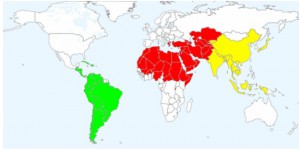
One World, Three Reporting Domains
There are 249 sovereign territories, one sovereign military order, and a few bits of terra nullius that remain unclaimed for obscure reasons. The foreign policy challenges the U.S. faces can be separated into three broad geographic zones – Central & South America, The Muslim World, and the Pacific Rim & Southeast Asia.
I had a good reading background and I spent the first quarter of 2013 focused on The Muslim World. Having sorted out the good news sources and collected a bunch of maps in the process, I determined that simply staying on top of happenings is a full time job. I have not done the same with the other two regions, but I am going to assume that the Pacific Rim & Southeast Asia is roughly the same volume of work, while Central & South America is slightly less busy.
During the last six months I also examined emerging technology and hive mind constructions that focused on foreign policy, which I summarized in Professionalism & Propaganda. I wrote more specifically about which hive minds and technology had caught my attention in Confusion & Disinformation. Balances of power are shifting, old relationships can become less important, while new ones are invaluable to understanding and shaping what comes next. Social Network Engineering introduced a ‘before’ snapshot of those hive minds I took an interest in, and we’ll come back to this in six months to see if we can discern new relationships and new venues for conversation.
A lone individual can study the players, the methods, and the issues, but I judge that a single player trying to stay on top of all three regions would need a nine day week of thirty six hours days. An attempt to watching it all would require one to dial back resolution to the point where most of what matters would be caught after it hits the press, and that’s too late.

The map of the three geographic regions is a sensible division of the task of sense making for a world in conflict. One knowledgeable analyst for each area would suffice. There are some horizontal slices that could be made as well – one could look at alleged terror reports across all three, or staple commodity prices, or any number of other clusters of indicators. That all comes later, first one needs regional subject matter experts who are on top of their game.
I have said some things about tools over the last six months with a strong bias for things that are either free or open. Social network and other link analysis tasks can be done with Maltego and Gephi. The only freely available means of handling information with temporal data included is Splunk and perhaps more importantly their software as a service, Splunk Storm. I have attended webinars on Precog, Tableau, and I poked around a bit within DataScienceCentral’s social network. This last area bedevils me, because I don’t have a lot of data that needs quantitive attention – this would be found in long term predictive work for a given region or in one of the horizontal slices such as commodities prices.
There are a couple of lingering issues from the domestic politics realm that seem likely to resolve themselves in the nine remaining days of May. I largely exited that scene six months ago, but I have faced a declining stream of callbacks, mostly to due to the fact there are some obscure episodes for which I am the keeper of the least incoherent timeline. I am treating this as a time to study and write, and I have been seeking an overall strategic view.
I recently completed the National Defense University’s Convergence, a collection of studies on illicit network threats. The narco-networks of Central & South America and the terror finance and facilitation in The Muslim World featured prominently. A major theme of the 21st century will be small, flexible networks having their way with large hierarchies. This book was focused on counter-insurgency and enforcement options, but those are dubious luxuries for an empire in decline.
New Directions is another NDU book which covers seven major strategic reports which define how we see ourselves in the context of the world. I had read the Quadrennial Diplomacy & Development Review, but not the six other reports. These include the Quadrennial Defense Review, related documents on nuclear proliferation, ballistic missile defense, NATO, and the White House’s overall National Security Strategy document. I have curated the reports themselves into the New Directions collection for future reference.
We face three unprecedented problems which are nearly impossible for status quo think tanks to handle. Our financial sector is a rotten husk. Our liquid fuel supplies are not going to be stable over the long term. And we really need to visualize 400ppm CO2 in terms of coastal cities and arable land. Right now we’re pretending the 21st century is going to be much like the 20th. Nothing could be further from the truth.



